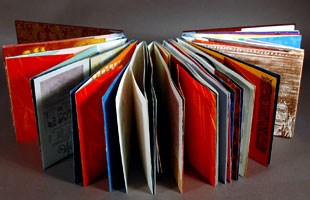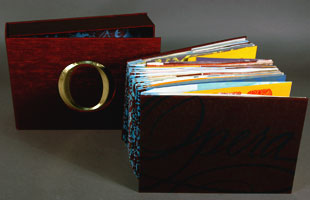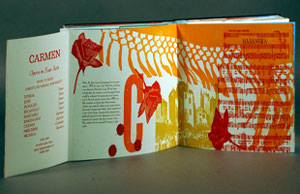Al-Mutanabbi
Street
On March 5th, 2007, a car bomb exploded on al-Mutanabbi Street near
the old quarter of Baghdad in Iraq. Named after the 10th century classical Iraqi poet Al-Mutanabbi,
the street was filled with bookstores and outdoor book stalls and was
considered to be the heart and soul of the Baghdad literary and intellectual
community. More than 30 people were killed and more than 100 wounded in the
explosion, and the street and its community were destroyed.
One response to the attack was the formation of another community,
this one of international artists and writers, who came together to produce a
collection of broadsheets, artists’ books, and writings expressing the broader artistic
community’s solidarity with that of Iraq. Instigated by a San Francisco
bookseller, Beau Beausoleil, artists were invited to submit broadsheets,
artists’ books and writings to commemorate this tragic event. This coalition of
contributing artists calls itself the Al-Mutanabbi
Street Starts Here Coalition. Since its formation the coalition has sought
to support and promote awareness of the enduring nature of the written word,
art, and freedom of expression. The attack on Al-Mutanabbi Street has been seen
as an assault on these basic principles, as well as on the artistic community
as a whole, and that the suffering of Al-Mutanabbi Street, its community, its
businesses, and what it represents in the wider cultural context, is shared by
the global cultural community. Each artist was requested to create 3 copies of
their response that would reflect both the strength
and fragility of books, but would also show the endurance of the ideas they
express. Here at the Herron Library we are fortunate to have, as part of
our permanent collection, three of the works created in response to the
bombing. A complete set of all the books will be donated to the Iraq National
Library in Baghdad. Another set will tour the world demonstrating the
universality of the artistic response. The Herron Library has been chosen as
one of the libraries that will co-curate and exhibit the entire collection of
over 250 books and broadsheets. This will take place in October, 2014.
In the Herron Art Library the following 3 artists’ books
are on permanent display.
 Memento
Memento
By Julie Chen
Berkeley [California]: Flying Fish Press, 2012. Number 12 of an edition of 50.
A custom-made copper case/locket (1.8125 x 2.375 x
0.75") by Christina Kemp houses on one side a miniature book (1.5 x 2.125
x 0.375", 56 pages) letterpress printed on Kitakata and opens on the other
side to reveal a triptych. The case/locket and a web strip (for wearing the
locket) are housed in cavities in a padded clamshell box (5.625 x 6.75 x
2.875") with title on the cover. The colophon slips into a groove in the
box's base. Materials: copper box: bookcloth; binder's board; satin;
plexiglass.
Julie Chen: "Memento is about the fragility of the book
and the power of reading. It includes a miniature book that is housed in a
metal locket that allows the reader to wear the book close to the body. The
simple act of carrying a book on one's person has diverse implications
depending on circumstance and place. The locket also houses a triptych that
contains a woven token commemorating Al-Mutanabbi Street in Iraq. The texts on
the woven strips are taken from the preambles to the constitutions of the
United States and Iraq. The image surrounding the token is of a booksellers
stall on Al-Mutanabbi Street prior to the bombing in 2007. While the
commemorative aspect of this piece is clear, the content of Memento addresses philosophical questions
about the nature of reading and information transfer in our own lives as well
as within the context of western culture in general. This edition is part of An
Inventory of Al-Mutanabbi Street."
Memory
of Al-Mutanabbi Street
Four rectangular pieces of tan paper folded into three over-lapping layers and attached at one end to a black and gray houndstooth print fabric and pasteboard cover. The book consists of the names
of people who were killed in the car bombing, inscribed around an endless screw
and pulled by a red thread. The graphics were inspired by the lintels of wood
carving “ham yo“) placed at the front of the houses to protect against “the
wrong spirits” (Asia).(Artist’s description)
Memory of Al-Mutanabbi Street
And a second title in Christine Kermaire’s “An Inventory of
Al-Mutanabbi Street” trilogy:
Future of Al-Mutanabbi Street
by Christine Kermaire
.jpg) |
| Future of Al-Mutanabbi Street |
Contains nine mounted miniature
printed books with marbled paper covers, each containing the same English
language text of a poetic passage by the Iraqi poet Al-Mutanabbi, and
bound in hounds- tooth silk-screened cloth.
Event
The Herron Art Library will host a reading on March 5th, 2014 (4-6 pm) to commemorate the bombing of
Al-Mutanabbi Street. The event is free and open to the public. These books and
a selection of broadsheets created in response to the bombing are on display.






.jpg)